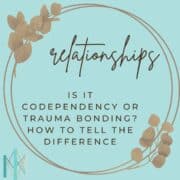
Many people who find themselves in difficult or unhealthy relationships ask the same question: Am I experiencing codependency, or am I trapped in a trauma bond? While these two patterns share similarities—both involve attachment to relationships that may be harmful—there are key distinctions between them that are essential for understanding your experiences and healing effectively.
Codependency and trauma bonding often develop as responses to relational instability, neglect, or abuse, but they function in distinct ways. Codependency is generally rooted in a learned pattern of over-functioning in relationships—an attempt to earn security and validation through caretaking, people-pleasing, and emotional dependency. Trauma bonding, on the other hand, occurs when an individual becomes psychologically and biologically tethered to an abuser through cycles of reward and punishment, creating a form of emotional addiction.

What Is Codependency?
Codependency is a behavioral and emotional pattern in which a person’s self-worth becomes deeply entangled in taking care of others. While commonly discussed in the context of relationships with addicts or narcissists, codependency can emerge in any relationship dynamic where one person consistently over-functions while the other under-functions.
Key Features of Codependency:
- A deep-seated need to be needed, often at the expense of personal well-being
- Difficulty setting and maintaining healthy emotional boundaries
- A tendency to over-give, over-accommodate, or take responsibility for others’ emotions
- Fear of abandonment or rejection, leading to excessive people-pleasing
- Self-worth tied to how much one can help or “fix” others
At its core, codependency is about control—not necessarily in a malicious sense, but rather as a way of managing one’s own anxiety by attempting to stabilize or “rescue” others. This can lead to enabling behaviors, exhaustion, and difficulty recognizing one’s own needs.
What Is Trauma Bonding?
Trauma bonding is a psychological attachment that forms in abusive relationships, often fueled by cycles of intermittent reinforcement—alternating periods of affection and cruelty that create emotional dependence. It is particularly common in relationships with narcissists, abusers, and manipulators who use emotional highs and lows to keep a person attached.
Key Features of Trauma Bonding:
- Intense emotional attachment to someone who causes harm
- A cycle of abuse and reconciliation, where painful experiences are followed by affection, apologies, or love bombing
- An inability to leave the relationship, even when it is actively damaging to one’s well-being
- Minimizing, rationalizing, or blaming oneself for the abuser’s behavior
- Feeling emotionally addicted to the highs and lows of the relationship
Trauma bonding often stems from early experiences of relational inconsistency, neglect, or abuse, where love and pain were closely intertwined. Over time, this creates a neurobiological pattern of craving and withdrawal, reinforcing the bond to the person causing harm.
Codependency vs. Trauma Bonding: Key Differences
While codependency and trauma bonding can overlap, their core drivers and functions differ.
Why These Differences Matter
Understanding these differences is crucial because codependency can exist without abuse, while trauma bonding is inherently linked to an abusive cycle. Someone who is codependent may struggle with enmeshment and boundary-setting, but they are not necessarily stuck in an ongoing cycle of psychological harm and manipulation. Trauma bonding, on the other hand, creates a powerful neurological and emotional tie to an abuser, making it much more difficult to break free without specialized intervention.
How to Heal: Recovery Strategies for Both Codependency and Trauma Bonding
Breaking free from unhealthy relational patterns requires more than just recognizing them—it involves retraining emotional, cognitive, and even physiological responses that have been shaped by past experiences. Recovery looks different depending on whether you are healing from codependency or trauma bonding, as each pattern is rooted in distinct psychological mechanisms.
For those struggling with codependency, healing often involves learning to prioritize self-worth outside of relationships, set boundaries without guilt, and develop internal validation rather than relying on external approval. On the other hand, recovering from trauma bonding requires breaking cycles of intermittent reinforcement, addressing the nervous system’s response to abuse, and unlearning deeply ingrained beliefs that equate love with suffering.
Healing from Codependency
Codependency recovery focuses on reclaiming identity, setting boundaries, and developing self-worth outside of relationships.
- Therapy and self-awareness work – Understanding the patterns of over-functioning and learning to tolerate emotional discomfort without overgiving
- Setting and reinforcing boundaries – Learning that healthy limits do not mean rejection or failure
- Developing emotional self-regulation – Working on self-soothing and validation from within, rather than from external approval
- Shifting from external caretaking to self-care – Prioritizing individual goals, interests, and needs
Healing from Trauma Bonding
Breaking a trauma bond requires rewiring the nervous system and unlearning toxic attachment patterns.
- No-contact or limited contact – Physically and emotionally separating from the abusive relationship
- Therapeutic intervention for trauma processing – Working through PTSD, attachment wounds, and nervous system dysregulation
- Cognitive reframing and reality testing – Identifying and dismantling false narratives and self-blame
- Addressing the neurobiological addiction – Understanding that trauma bonding is not just emotional, but also chemical, requiring structured healing methods
While both codependency and trauma bonding require deep emotional work, trauma bonding often requires trauma-focused therapy, as it is rooted in biological conditioning rather than just learned relational behaviors.
Codependency or Trauma Bonding – Can It Be Both? (And How Can You Tell?)
In many cases, codependency and trauma bonding overlap, making it difficult to determine which pattern is at play in a relationship. While they have distinct roots—codependency being a learned relational pattern and trauma bonding being a response to an abusive cycle—they can exist together, reinforcing one another in ways that make leaving unhealthy relationships even harder.
How Codependency and Trauma Bonding Can Coexist
Someone with codependent tendencies may become trauma bonded in a relationship where emotional highs and lows create an addictive attachment. For example:
- A person who has learned to equate love with caretaking (codependency) may stay in a relationship with an abusive or manipulative partner, even as they endure cycles of mistreatment and intermittent affection (trauma bonding).
- A person with deep-seated fear of abandonment (codependency) may rationalize an abuser’s behavior, convincing themselves that if they love harder or prove their worth, the abuse will stop (trauma bonding).
- A partner who over-functions and feels responsible for someone else’s well-being (codependency) may struggle to leave an abuser who occasionally provides warmth and reassurance after a period of mistreatment (trauma bonding).
While codependency does not always involve abuse, trauma bonding always does—which is the key distinction between the two.
How Can You Tell If You’re Experiencing One or Both?
To determine whether you are experiencing codependency, trauma bonding, or both, consider the following questions:
- Do you feel emotionally dependent on someone, even when the relationship is hurting you? If you find yourself seeking validation and connection despite experiencing harm, trauma bonding may be at play.
- Are you driven by the need to help, fix, or save the other person? If your role in the relationship revolves around caretaking, emotional labor, or people-pleasing, it is more likely codependency.
- Does the relationship involve cycles of emotional highs and lows, where moments of kindness or affection keep you from leaving? This pattern of intermittent reinforcement is a hallmark of trauma bonding.
- Do you fear that setting boundaries or leaving will cause you to lose your sense of identity or purpose? This can be a sign of codependency, especially if your self-worth is deeply tied to the relationship.
- Do you minimize or justify mistreatment, telling yourself it’s not that bad or that you can change the other person? This is a key feature of trauma bonding, as the brain seeks to rationalize staying in an unsafe dynamic.
- Do you feel physically or psychologically unable to leave, even when you know the relationship is harming you? This is more common in trauma bonding, where the nervous system becomes wired to the cycle of abuse and reconciliation.
What to Do If You Recognize These Patterns
If you resonate with both codependency and trauma bonding, it’s important to recognize that the longer these patterns persist, the harder they can be to break without support. Therapy can help you:
- Identify and challenge false beliefs that keep you stuck in unhealthy relationships
- Rebuild self-worth that is independent of your role as a caretaker or partner
- Recognize the neurological effects of trauma bonding and develop strategies to break free
- Practice boundary-setting and emotional regulation to create healthier connections
Whether you are dealing with codependency, trauma bonding, or both, healing is possible. The first step is acknowledging these patterns and seeking the right support to help you reclaim your emotional independence.
Browse our Therapist Directory




